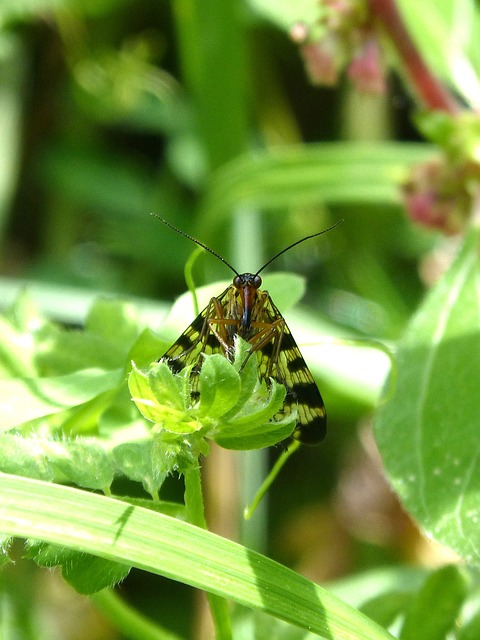Scorpion control in Tucson is essential given the city's desert climate promotes a thriving scorpion population. These arachnids are most active from April to October, coinciding with the warmer months. Their reproductive cycle peaks in spring with egg-laying and results in the birth of young between mid-summer and early fall. Tucson's scorpions grow rapidly through molting and reach maturity within one to two years. As temperatures rise, there's an increased risk of scorpions entering homes in search of food and shelter, necessitating measures to control their presence. Residents are advised to seal entry points, maintain clean living spaces, and judiciously apply pesticides. Understanding the scorpions' seasonal behavior and environmental preferences is crucial for effective management. Tucson's unique habitat, with its extreme heat and limited water, influences scorpion distribution and activity patterns. Scorpion control Tucson services offer a range of solutions, including non-toxic alternatives like diatomaceous earth, to manage these pests effectively. By combining professional treatments with ongoing maintenance, residents can significantly reduce the risk of scorpion encounters throughout the year, ensuring a safer coexistence within the Sonoran Desert environment.
Tucson’s arid landscape serves as a natural habitat for a diverse array of creatures, with scorpions being particularly prominent. This article delves into the seasonal activity patterns of these often-misunderstood arachnids and their adaptation to Tucson’s environment. By exploring their lifecycle stages and environmental triggers, we aim to shed light on the best practices for effective scorpion control in Tucson homes throughout the year. Understanding the intricate behaviors and preferences of these creatures is not only crucial for coexistence but also vital for implementing targeted strategies that ensure both safety and humane treatment. Join us as we unravel the mysteries behind Tucson’s seasonal scorpion dynamics, with a focus on sustainable scorpion control measures.
- Deciphering the Rhythms: The Lifecycle and Seasonal Activity of Tucson Scorpions
- Environmental Factors Influencing Scorpion Behavior in Tucson's Ecosystem
- Strategies for Effective Scorpion Control in Tucson Homes Year-Round
Deciphering the Rhythms: The Lifecycle and Seasonal Activity of Tucson Scorpions

Scorpions in Tucson, Arizona, exhibit distinct seasonal activity patterns that are influenced by the region’s climate and environment. These arachnids are most active during the warmer months, typically from April to October, when higher temperatures coax them out of their daytime hiding spots to hunt for food. The lifecycle of Tucson scorpions is segmented into stages that mirror the seasons: egg-laying occurs in late spring and early summer, with females giving birth to live young between June and August. The newborn scorpions, known as pinchers due to their small size, grow rapidly through a series of molts, eventually reaching maturity within one to two years.
Understanding the seasonal activity of Tucson scorpions is crucial for effective scorpion control measures. As temperatures rise, scorpions become more active and are more likely to enter human habitats in search of prey and shelter. Homeowners often seek scorpion control solutions during this time, as encounters with these creatures can be both startling and potentially harmful, given that some species secrete a venomous sting. Employing strategic scorpion control Tucson methods, such as sealing entry points, maintaining clean environments, and using targeted pesticides when necessary, can help manage populations and reduce the risk of encounters. By monitoring these seasonal patterns and implementing preventative measures, residents can better coexist with these intriguing inhabitants of the Sonoran Desert.
Environmental Factors Influencing Scorpion Behavior in Tucson's Ecosystem

In Tucson, the diverse and arid ecosystem provides a unique environment that shapes the behavior and activity patterns of scorpions. The Sonoran Desert’s distinct seasons, characterized by hot summers and mild winters, dictate the movement and reproduction cycles of these arachnids. Scorpion control in Tucson is most effective when considering these environmental factors. For instance, during the hotter months, scorpions are more active at night, seeking refuge in cooler habitats such as beneath rocks or in moist soil during the day. The scarcity of water, a critical resource, drives their behavior towards areas with higher humidity and the presence of organic matter, which can indicate potential moisture sources.
Furthermore, the availability of food sources, particularly insects and other small arthropods that scorpions prey upon, also influences their distribution and abundance within the region. The interaction between these resources and the harsh conditions of the environment leads to a patchy distribution of scorpion populations across Tucson’s ecosystem. Understanding these patterns is crucial for implementing targeted scorpion control measures. By recognizing when and where scorpions are most active, residents can take proactive steps to reduce encounters with these creatures, such as sealing entry points into dwellings and maintaining clean, well-lit areas around homes. This approach not only enhances the safety of Tucson’s inhabitants but also helps preserve the delicate balance of this unique desert ecosystem.
Strategies for Effective Scorpion Control in Tucson Homes Year-Round

In Tucson, Arizona, scorpion control is a year-round endeavor due to the region’s warm and arid climate, which supports a thriving scorpion population. Effective scorpion control in Tucson homes involves a multifaceted approach that includes environmental management and proactive pest control measures. Homeowners should focus on sealing potential entry points, as scorpions seek shelter indoors during the day to escape the harsh midday heat. Regularly inspecting the foundation, windows, and doors for cracks or gaps can prevent these arachnids from entering living spaces. Additionally, maintaining cleanliness, especially in areas where food is prepared and stored, reduces the attractiveness of homes to scorpions. Keeping yards free of debris and clutter, as well as removing any rocks or wood piles that might serve as hiding spots, further deters scorpions from making a home too close for comfort.
Employing scorpion control Tucson services, which may include the use of insecticides or non-toxic alternatives like diatomaceous earth, can effectively manage scorpion populations. Glow-in-the-dark lighting can be installed around the perimeter of homes to visually monitor for scorpions at night, as they are nocturnal creatures. Regular monitoring and proactive treatment by trained professionals specializing in scorpion control Tucson are crucial for maintaining a safe environment. These experts can identify high-risk areas within and around homes, recommend the most effective control methods tailored to each household’s specific situation, and provide ongoing maintenance to prevent future infestations. By combining these strategies with vigilance and a proactive approach, Tucson residents can significantly reduce the presence of scorpions in their living spaces year-round.
In conclusion, the seasonal activity patterns of Tucson scorpions are a testament to their remarkable adaptation to the region’s unique environmental conditions. By understanding these patterns, as detailed in “Deciphering the Rhythms: The Lifecycle and Seasonal Activity of Tucson Scorpions,” residents can better anticipate and mitigate potential encounters with these arachnids. Environmental factors play a pivotal role in scorpion behavior, as highlighted in “Environmental Factors Influencing Scorpion Behavior in Tucson’s Ecosystem.” Armed with this knowledge, effective scorpion control measures can be implemented year-round, a critical aspect of coexisting safely with these creatures. Strategies for Effective Scorpion Control in Tucson Homes Year-Round ensure that homes remain secure environments, reducing the likelihood of unwanted scorpion inhabitants. For comprehensive scorpion control solutions tailored to Tucson’s specific ecological context, residents are encouraged to consult experts and adopt proactive measures throughout the year.